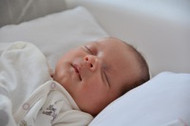Breaking Bad Baby Sleep Habits
13th Jun 2016
 When our children are infants, we do everything in our power
to help them sleep. Sleep is immeasurably important, so doctors and parenting
experts encourage us to coax them to sleep however we can – rocking, swaddling,
cuddling, nursing…
When our children are infants, we do everything in our power
to help them sleep. Sleep is immeasurably important, so doctors and parenting
experts encourage us to coax them to sleep however we can – rocking, swaddling,
cuddling, nursing…
Over time, our children learn to associate these comforting acts with sleep. The consistency soothes them right into slumber. At some point, however, these tactics go from “just helpful” to “absolutely necessary.” This is called a sleep association.
The problem with a sleep association is that your baby needs a specific environment recreated every time. You may not mind cuddling them to sleep just before bedtime, but you won’t want to do that once or twice a night every night because it’s the only way they know how to go back to sleep.
Here’s what to know about sleep associations and how you can stop them.
1. Improve the bedtime routine
If your bedtime routine is done properly, your baby should begin to fall asleep once the bedtime cues begin coming in. The idea is to switch your baby’s mind into “sleep mode” so they don’t require rocking, cuddling, back rubbing, breastfeeding, or anything else to do it.
Your bedtime routine can be pretty much anything, as long as it’s quiet, relaxed, and consistent. Popular routine elements are reading books, baths, playing with one or two toys in bed, or just talking in a chair or bed.
The goal is to make your child mentally ready for sleep when you lay them down in the crib.
2. Some sleep aids are OK
It’s important to make sure that mom or dad aren’t the sleep aid, but that doesn’t mean all sleep aids are bad. Thumb-sucking, pacifiers (for a while), white noise, and favorite loveys are perfectly fine because they don’t require mom or dad’s help.
Your child will naturally grow out of needing these aids on his/her own time. Even if you have to break your child from one of these sleep aids, it can be done once regular, healthy sleep is well established.
3. Place baby in the crib before he/she falls asleep
If you let your child fall asleep in your lap or at your breast, you’re just reinforcing the routine. Mommy or daddy has become the preferred place to fall asleep. You have to lay baby down and leave the room so he/she falls asleep alone.
Yes, there might be some protesting. I know it’s tough to hear, but as long as he/she isn’t wailing uncontrollably, everything will be fine. If your baby wakes up at night, it’s fine to go in and comfort him/her, but do not take baby out of the crib. Just provide a gentle voice and touch.
Did your child ever struggle with sleep associations?
Written by Alicia Overby - Founder & President of Baby Elephant Ears
Alicia is wife, mother, and creator of Baby Elephant Ears. Baby Elephant Ears was created out of parental concern, not financial desire. In 2005, when their second child was an infant, he cried all the time and just couldn't seem to get comfortable.
After seeking advice and suggestion from the medical community and alternative medicine, they eventually ended up in the chiropractors office where their baby was successfully treated for asubluxation, discomfort most likely the result of the strain during labor, which was now being exacerbated by the normal lack of infant neck strength. Only proper neck, head, and back alignment would offer him relief. When they couldn't find a product to give their baby the necessary support, Alicia took matters into her own hands and crafted her own infant support pillow. The first Baby Elephant Ears was born!
For more information, visit www.babyelephantears.com.
Interested in writing a guest blog for Baby Elephant Ears? Send your topic idea to pr@babyelephantears.com.
All data and information provided on this site is for informational purposes only. Baby Elephant Ears makes no representations as to accuracy, completeness, current-ness, suitability, or validity of any information on this site and will not be liable for any errors, omissions, or delays in this information, or any losses, injuries, or damages arising from its display or use. All information is provided on an as-is basis.


